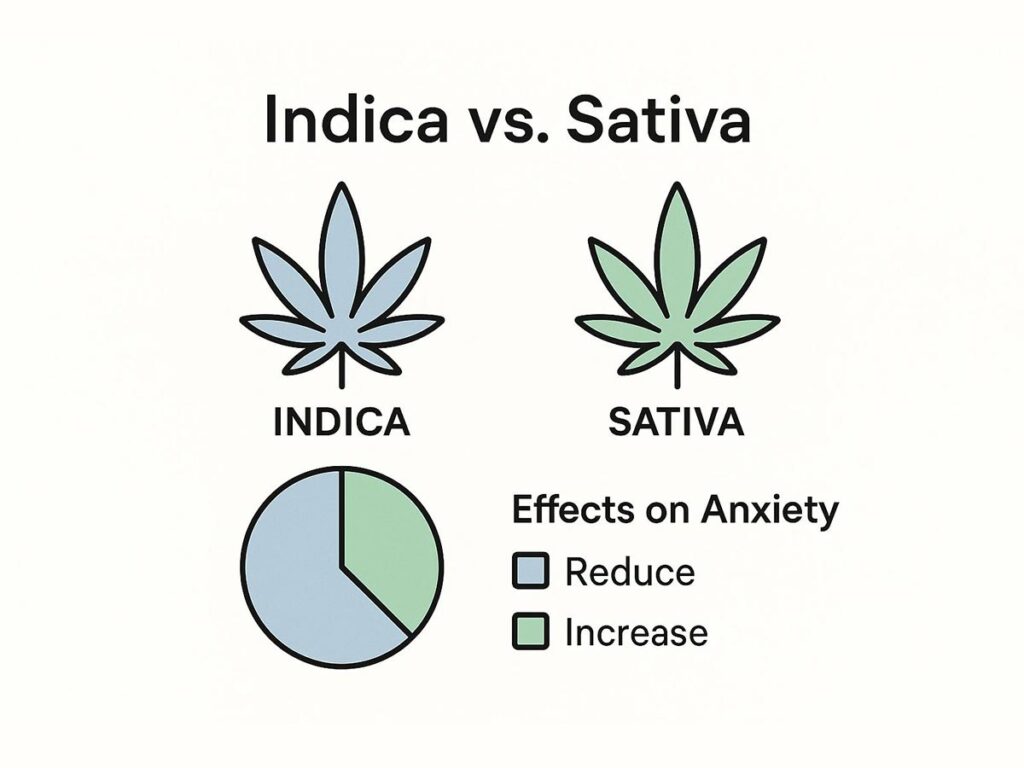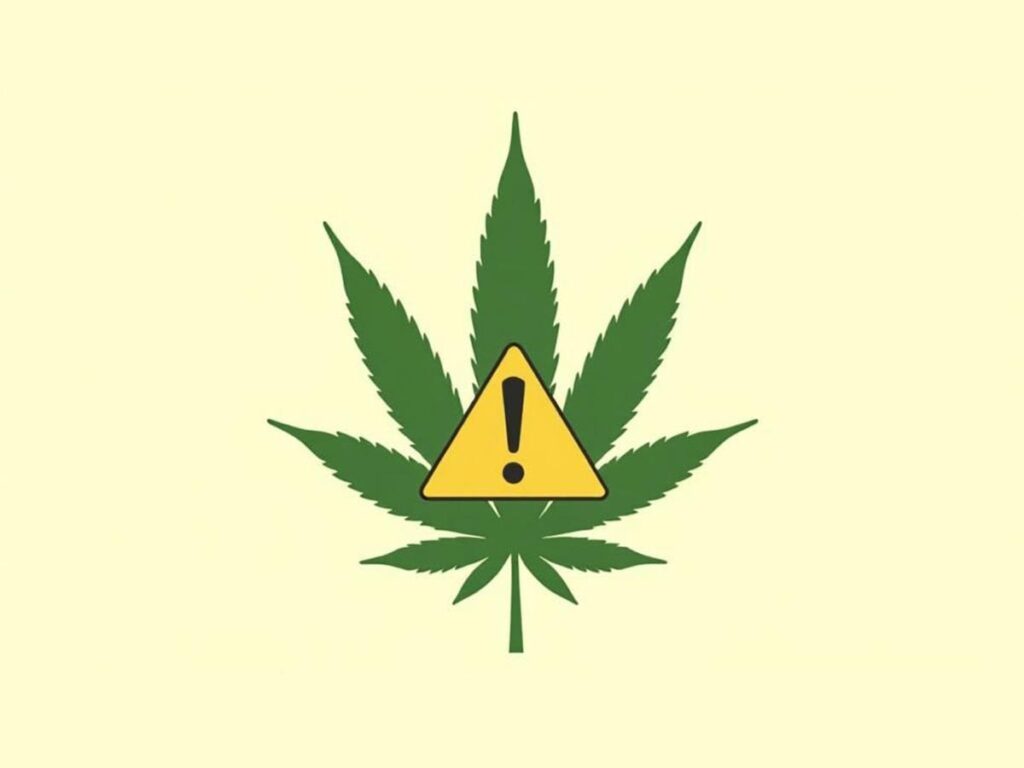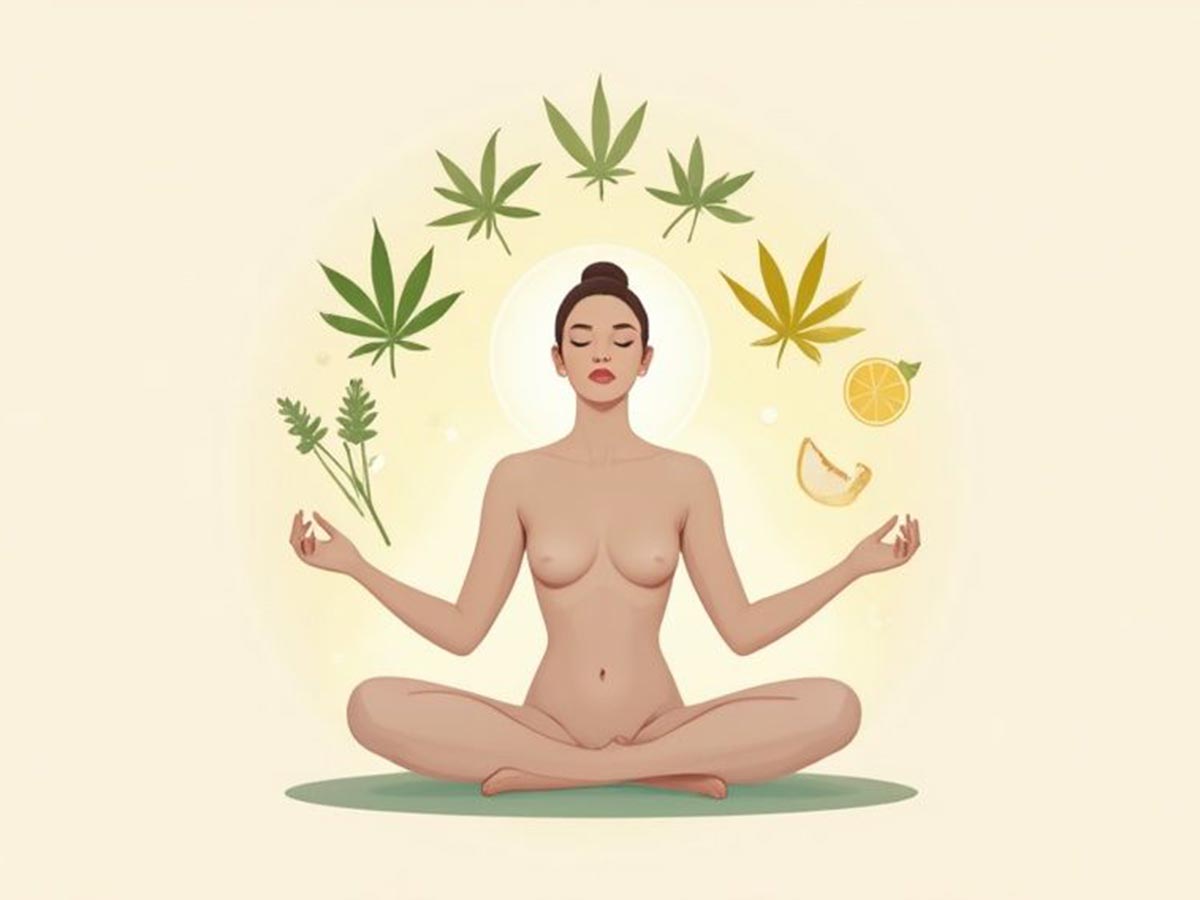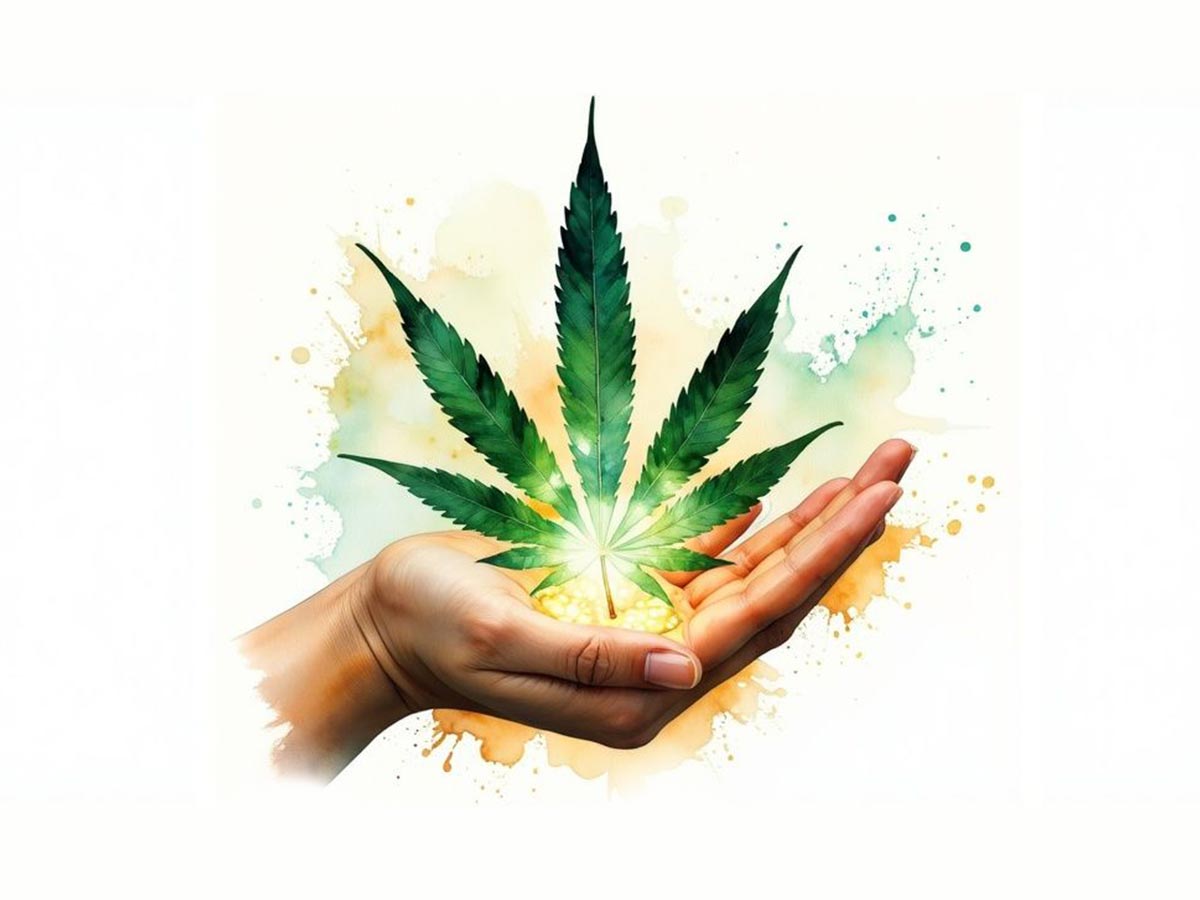If you’re looking for the best cannabis strains to help with anxiety, a great place to start is with cultivars known for their calming, balanced effects. Strains with a higher ratio of CBD to THC, like ACDC or Harle-Tsu, are often go-to recommendations. They can offer a sense of relaxation without the intense psychoactive “high,” which makes them a comfortable entry point for many people.
How Cannabis Can Help Soothe Anxiety

Finding the right cannabis strains for anxiety is less about a one-size-fits-all answer and more about a personal journey. It all starts with understanding how the plant actually works with your body. The experience you get is shaped entirely by the unique chemical profile of each specific strain.
This profile is a complex mix of compounds, primarily cannabinoids and terpenes. You’ve probably heard of the two most famous cannabinoids: THC (Tetrahydrocannabinol), the one responsible for the “high,” and CBD (Cannabidiol), which is celebrated for its non-intoxicating, calming properties. Terpenes, on the other hand, are the aromatic oils that give different strains their signature scents—think citrus, pine, or lavender.
The Power of the Entourage Effect
Here’s where it gets interesting: these compounds don’t just work on their own. They interact with each other in a synergistic dance called the entourage effect. The idea is that the combined effect of all these compounds working together is far more powerful than any one of them working in isolation.
Think of it like a band. THC might be the flashy lead guitarist, driving the main vibe. CBD is the steady bassist, holding down the rhythm and keeping everything grounded. The terpenes are like the drummer and keyboardist, adding all the subtle layers and textures that make the song truly special.
This beautiful interaction is exactly why two strains with the same THC percentage can feel completely different. One might leave you feeling uplifted and focused, while another brings on a wave of deep relaxation. It’s this unique blend of cannabinoids and terpenes that truly defines the final therapeutic experience. For a closer look at how these components team up, you can explore our guide on full-spectrum cannabis.
Grasping this concept is the first real step toward making a smart choice. Once you learn to look past just the THC number and start considering the entire chemical orchestra, you’ll be much better equipped to find a strain that brings you the peace and quiet you’re looking for.
The Balancing Act: How THC and CBD Work Together
When you’re looking at cannabis to help with anxiety, the two names you’ll see everywhere are THC (Tetrahydrocannabinol) and CBD (Cannabidiol). Getting a handle on what they do is the first step to finding real relief.
Think of it like this: THC is the gas pedal. It can create that uplifting, euphoric feeling, but if you press it too hard, you might spin out and find your anxiety is actually worse. It’s the compound responsible for the “high,” and a little can go a long way.
CBD, on the other hand, is like the brakes and steering. It’s not psychoactive, so it won’t get you high. Instead, it works behind the scenes to smooth out the ride, tempering THC’s intensity and bringing its own powerful calming and balancing effects to the table. This is why the ratio of THC to CBD is so incredibly important for anxiety.
Finding Your Sweet Spot: THC to CBD Ratio
For most people navigating anxiety, strains with more CBD than THC are the way to go. This kind of profile gives you the gentle, therapeutic benefits of the plant without sending you into an overwhelming psychoactive experience that could easily make you feel more anxious.
A balanced or CBD-forward strain helps you stay grounded and clear-headed while still easing that feeling of being on edge.
Take a well-known strain like Ringo’s Gift, for example. It’s famous for its sky-high CBD content, sometimes hitting over 24% CBD with less than 1% THC. This profile is a game-changer for anxiety because you get all the anxiolytic (anti-anxiety) properties of CBD without the potential paranoia that high-THC strains can sometimes provoke.
The image below gives a general idea of how different cannabis types, traditionally known as Indica and Sativa, are often thought to affect anxiety.

While these labels can be a helpful starting point, remember that the true effects come down to the unique mix of cannabinoids and terpenes in each specific strain. If you’re curious, you can learn more about the real difference between Indica and Sativa.
THC vs. CBD: A Quick Comparison for Anxiety Management
To really nail down the difference, let’s put these two cannabinoids side-by-side. Knowing how they contrast will help you read product labels with confidence and choose what’s right for you.
| Characteristic | THC (Tetrahydrocannabinol) | CBD (Cannabidiol) |
|---|---|---|
| Psychoactivity | High (produces a “high”) | None (non-intoxicating) |
| Anxiety Potential | Can increase anxiety at high doses | Generally reduces anxiety |
| Primary Effect | Euphoric, uplifting, psychoactive | Calming, relaxing, balancing |
| Ideal Use Case | Experienced users seeking a mood lift in moderation | Anyone needing clear-headed relief, anytime |
In the end, it’s all about finding that personal balance. A great strategy is to start with a strain that is either CBD-dominant or has a balanced 1:1 ratio of THC to CBD. This approach lets you test the waters safely, giving you a much better chance of finding relief without any unwanted side effects.
Why Terpenes Matter for Anxiety Relief
When we talk about cannabis, THC and CBD tend to steal the spotlight. But they’re only two actors in a much larger play. The real secret to a strain’s anxiety-soothing power often comes down to its terpenes—the fragrant oils responsible for a plant’s unique smell and taste.
Think of it like aromatherapy. Ever wonder why the smell of lavender helps you unwind? That’s a terpene called linalool at work. Cannabis operates on the same principle. These aromatic compounds aren’t just for show; they work alongside cannabinoids to shape the entire experience.
Understanding this is a game-changer when you’re looking for anxiety relief. A strain’s specific blend of terpenes can be the difference between feeling uplifted and calm or energized and focused. It’s what allows you to look past the THC percentage and get a real sense of what a strain can do for you.
Key Terpenes for Calming Anxiety
When you start digging into lab reports or product descriptions, you’ll see a few names pop up again and again. Getting to know these terpenes will drastically improve your odds of finding a strain that truly clicks with your body.
Here are four of the most reliable allies in the fight against anxiety:
- Myrcene: The most abundant terpene in cannabis, myrcene has an earthy, musky scent with a hint of fruit, like a ripe mango. It’s the go-to for deep relaxation, famous for producing those heavy, “couch-lock” effects that can silence a racing mind. Practical example: The strain Granddaddy Purple is rich in myrcene, which is why it’s a popular choice for evening use to calm anxious thoughts before sleep.
- Linalool: With its classic floral, lavender-like aroma, linalool is practically synonymous with calm. Strains high in linalool are fantastic for easing stress and bringing on a feeling of peace, much like its aromatherapy counterpart. Practical example: Strains like Do-Si-Dos and Lavender Kush often contain high levels of linalool, contributing to their reputation for stress relief.
- Limonene: Just as the name suggests, limonene smells bright and citrusy, like fresh lemon or orange peels. It’s known for its ability to lift your spirits and melt away stress, making it perfect for when anxiety has you feeling down. Practical example: Lemon Haze is a classic example of a limonene-dominant strain, often used to improve mood and provide an uplifting, anxiety-free buzz.
- Beta-Caryophyllene: This terpene carries the spicy, peppery scent of black pepper and cloves. What makes it so special is that it also binds to cannabinoid receptors in your body, directly engaging with your endocannabinoid system to dial down stress. You can learn more about how these fascinating compounds work on Wikipedia’s terpene page. Practical example: You’ll find beta-caryophyllene in strains like GSC (formerly Girl Scout Cookies), where it adds a layer of physical relaxation that can help ease body tension associated with anxiety.
By paying attention to these terpenes, you shift from just buying cannabis to making a strategic choice. You’re no longer guessing; you’re selecting a precise chemical profile to bring you the sense of calm you’re looking for. This knowledge is your best tool for navigating the vast world of cannabis with confidence.
Top Cannabis Strain Profiles for Anxiety

Alright, you’ve got the basics down on how cannabinoids and terpenes work. Now, let’s put that theory into practice. Instead of just throwing a long list of strain names at you, we’re going to look at three distinct profiles. This way, you can learn to match a strain’s chemical fingerprint to your own anxiety and what you want to feel.
It’s important to remember that the goal isn’t to chase the highest THC number on the label. The real art is finding a profile that delivers genuine relief, whether that’s for gentle daytime support or deep evening calm.
High-CBD, Low-THC Strains
This is the perfect starting line for most people, especially if you’re new to cannabis or know you’re sensitive to THC’s psychoactive side. These strains are all about CBD, delivering clear-headed relief without any noticeable “high.”
Think of this category as your daytime ally. It’s ideal for when you need to quiet a racing mind but still have to stay sharp and get things done. These strains are fantastic for managing general anxiety without that heavy, sleepy feeling.
- ACDC: This is a powerhouse of calm, often testing with a CBD-to-THC ratio around 20:1. It’s famous for melting away tension while leaving your focus intact.
- Harle-Tsu: A blend of Harlequin and Sour Tsunami, this strain is a favorite in the medical cannabis world for delivering powerful, non-intoxicating relief.
Balanced 1:1 THC and CBD Strains
If you need a little more oomph but still want to keep anxiety far away, balanced strains are your sweet spot. With a nearly equal ratio of THC and CBD, they offer a gentle, mild euphoria that’s perfectly grounded by CBD’s calming presence.
This profile is wonderful for moderate anxiety, easing into social situations, or sparking creativity without tipping you over the edge. The CBD essentially acts as a safety net, smoothing out the THC for a comfortable and pleasant experience.
Cannatonic is the poster child for balanced strains. It gives you a subtle mood lift along with serious physical relaxation, making it a top-tier choice when you need a gentle touch from both key cannabinoids.
THC-Dominant Strains with Calming Terpenes
This category is best for seasoned cannabis users who are already comfortable with how THC feels. The secret here isn’t just a high THC percentage; it’s finding strains that are also loaded with calming terpenes like myrcene, linalool, or beta-caryophyllene. These aromatic molecules steer the high toward relaxation, not paranoia.
Granddaddy Purple, for example, is a legendary indica known for its deep, full-body calm. That profound sense of peace comes from its high myrcene content, making it perfect for shutting down a busy mind before bed. If you’re new to THC-forward options, our guide on the best cannabis strains for beginners is a great place to start safely.
What’s interesting is that even some sativa-dominant strains are finding their place in anxiety relief. Take Sour Diesel—it’s loved for its energizing, mood-lifting effects that can cut right through the fog of anxiety without making you sleepy, all thanks to its unique terpene mix.
A Practical Guide to Dosing for Anxiety
Finding the right cannabis strain is a huge first step, but dialing in your perfect dose is where the real magic happens for anxiety relief. I can’t stress this enough: the golden rule is to start low and go slow. When you’re using cannabis to manage anxiety, especially anything with THC, less is almost always more.
This whole approach is about finding your minimum effective dose. Think of it as the sweet spot—the smallest amount you need to feel that wave of calm you’re looking for. It’s so easy to overdo it, and that’s the fastest way to turn potential relief into a panic attack. Starting small keeps you in the driver’s seat.
The “Start Low and Go Slow” Method in Action
Putting this into practice is pretty simple. It’s not about taking a big hit and hoping for the best. It’s about being patient and learning how your own body reacts, which is the key to getting relief without any unwanted side effects.
Here’s a step-by-step guide to get you started:
- Take a single, small puff. If you’re vaping or smoking, just one small inhalation is all you need. You don’t need to hold it in for a long time; just introduce a tiny amount into your system. For instance, use a dry herb vaporizer set to a low temperature (around 350°F or 177°C) for a smoother, more controllable experience.
- Set a timer and wait. Seriously. Put your vape or pipe down and set a timer for at least 20 minutes. The effects from inhaling come on fast, but you need to give them a moment to fully settle before you can really judge how you feel. Use this time to drink some water and relax.
- Check in with yourself. When the timer goes off, do a mental scan. Is your anxiety easing up a bit? Is the mental chatter quieting down? If you notice even a subtle positive shift, you might be done. That could be your dose.
- Repeat only if you need to. If you honestly feel no difference after 20 minutes, you can take one more small puff. Then, you guessed it—wait another 20 minutes and check in again.
This patient process is what keeps you from accidentally stumbling over that fine line where THC goes from helpful to overwhelming. The goal isn’t to get “high,” but to find a gentle sense of calm.
Choosing Your Consumption Method
How you consume cannabis makes a massive difference in how you dose it. Inhalation methods like vaporizing give you quick feedback, which makes it much easier to gauge the effects in real-time and fine-tune how much you’re taking in.
Edibles, on the other hand, are a completely different ballgame. They can provide much longer-lasting relief, which is great, but they have a seriously delayed fuse—often taking 30 minutes to two hours to kick in. This delay is what makes them so tricky for newcomers. It’s way too easy to get impatient, eat more, and then find yourself in an uncomfortably intense situation an hour later. If you want to get into the nitty-gritty science of cannabis and its compounds, Wikipedia offers a detailed overview that’s a good starting point.
Finding Your Own Way to Relief
When it comes to cannabis and anxiety, there’s no magic bullet. The real path to relief is a personal one—a journey of listening to your body and learning how it reacts to the incredible complexity of the cannabis plant.
Think of the key takeaways from this guide as your compass. You’ll want to pay close attention to the THC-to-CBD ratio to keep the psychoactive effects in check, look at the terpene profile for those specific calming aromas and effects, and—most importantly—always, always start low and go slow. A patient, mindful approach is the surest way to avoid feeling overwhelmed and find what truly helps.
Keep a Journal to Map Your Progress
To really get a handle on what works for you, try keeping a simple journal. It might sound like a hassle, but it’s the single best way to turn trial and error into a clear, personalized roadmap to relief.
- Strain Details: Jot down the name of the strain and its main cannabinoids and terpenes if you can find them. Example: “ACDC, 18% CBD, <1% THC, high in myrcene.”
- Dose and Method: Note exactly how much you used. Was it one puff from a vape? A 5mg gummy? Be specific. Example: “Vaped one 3-second puff at 350°F.”
- How You Felt: Describe your anxiety before and after. Did you feel calmer? Did your thoughts slow down? Any side effects? Example: “Felt a noticeable decrease in racing thoughts within 15 mins. No paranoia. Felt clear-headed.”
Over time, this log becomes your personal guide, showing you exactly which products and doses hit that sweet spot.
It’s interesting to note that a 2018 study found that while cannabis users with anxiety rated it highly effective for relief—giving it an average score of 8.03 out of 10—no single strain was the clear winner for everyone. This really drives home how much our individual body chemistry matters, making personal tracking invaluable. You can dive deeper into these findings on the National Center for Biotechnology Information website.
Ultimately, this journey is yours to navigate. Speaking with a healthcare professional or a well-informed cannabis consultant is always a smart move. Armed with the right knowledge and a willingness to experiment carefully, you can confidently explore your options and make choices that lead you toward a natural, lasting sense of calm.
Frequently Asked Questions
It’s completely normal to have a lot of questions when you’re thinking about using cannabis for anxiety. Let’s walk through some of the most common ones to help you feel more comfortable and informed.
Can Cannabis Make Anxiety Worse?
Yes, it’s possible, and this is a crucial point to understand. The experience isn’t always relaxing for everyone, especially if you get the strain or dosage wrong.
High-THC strains, particularly those without much CBD to balance them out, can sometimes ramp up your heart rate or bring on feelings of paranoia. For someone already struggling with anxiety, this can feel alarmingly similar to a panic attack. This is precisely why the “start low and go slow” mantra is your best friend. Easing in with a tiny dose of a CBD-rich or balanced strain is the smartest way to see how you react and avoid a bad time.
What’s the Difference Between Indica and Sativa for Anxiety?
You’ve probably heard the classic breakdown: Indica is “in-da-couch” for its relaxing, body-heavy effects, making it a go-to for winding down. Sativa is known for its energetic, creative head high, which sounds great for lifting your mood but can sometimes be too much for an anxious mind.
But here’s the thing: those old labels are becoming less and less useful. Modern cannabis science has shown us that it’s all about the specific cocktail of cannabinoids and terpenes in a strain. An Indica isn’t guaranteed to be calming, and a Sativa isn’t always racy. For example, a Sativa that’s loaded with a calming terpene like Linalool might actually be more relaxing than an Indica that lacks it.
How Long Do the Anti-Anxiety Effects Last?
This all comes down to how you choose to consume it. The delivery method dramatically changes how quickly you feel the effects and how long they stick around.
- Inhalation (Vaping/Smoking): This is the fast track. You’ll feel the effects in just a few minutes, but they’ll typically wear off within 1-3 hours. It’s great for immediate relief and gives you a lot of control over the dosage.
- Edibles: This is the marathon, not the sprint. It can take anywhere from 30 minutes to two full hours for edibles to kick in. Once they do, though, the effects can last for a solid 4-8 hours, sometimes longer. This offers long-lasting relief, but you have to be extremely careful with your dose.
Getting a handle on these timelines is a huge part of using cannabis safely and effectively. If you’re looking for more general information on how cannabis is classified, Wikipedia’s page on cannabis strains is a good starting point.
Ready to find a strain that might bring you some peace and clarity? The team at Elevation Headquarters lives and breathes this stuff, and we’re here to help guide you. Stop by the shop or check us out online to see a hand-picked selection of quality cannabis products. Find your perfect match at our cannabis shop.



